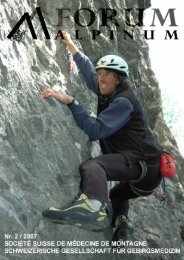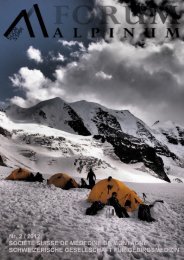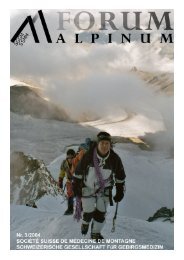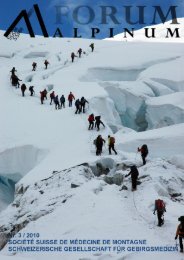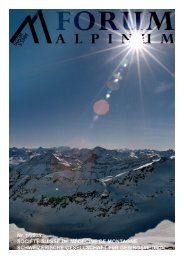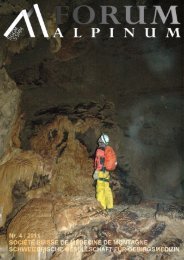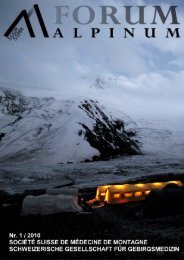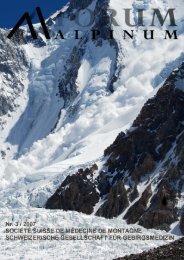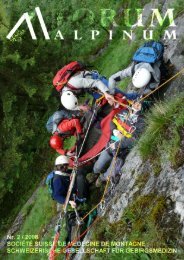abstracts 2010 - Schweizerische Gesellschaft für Gebirgsmedizin
abstracts 2010 - Schweizerische Gesellschaft für Gebirgsmedizin
abstracts 2010 - Schweizerische Gesellschaft für Gebirgsmedizin
Sie wollen auch ein ePaper? Erhöhen Sie die Reichweite Ihrer Titel.
YUMPU macht aus Druck-PDFs automatisch weboptimierte ePaper, die Google liebt.
RISK AND AVALANCHE RESCUE<br />
Krister Kristensen 1 *, Manuel Genswein 2 and Dale Atkins 3<br />
1 Norwegian Geotechnical Institute, Oslo, Norway, 2 Genswein, Meilen, Switzerland,<br />
3 RECCO AB, Boulder, Colorado, USA<br />
ABSTRACT: The risk to rescuers is of serious concern for the International Commission for Alpine Rescue<br />
(ICAR). For good reason, since ICAR receives annually reports of fellow rescuers injured or killed<br />
while on missions. In avalanche rescue many call outs occur when the general danger rating is 3 or higher<br />
and where conditions are further deteriorating. This means that both the approach and the accident<br />
site can be exposed to avalanche danger. Under these circumstances the risk of rescue missions in avalanche<br />
terrain can be comparable to settings where explosions, structure collapses, hazardous materials,<br />
etc., present a risk to the rescue personnel. This work outlines a decision analysis approach to risk and<br />
benefit assessments in avalanche rescue missions. A simulation-optimization model allows for assessing<br />
the expected outcomes of rescue missions by considering key variables affecting both rescuers and the<br />
buried subject. The large number of input variables, their probability and the interaction between the input<br />
variables lead to a level of complexity which is difficult to handle without a well-structured decision making<br />
tool.<br />
KEYWORDS: risk assessment, risk management, rescue simulation, rescuer safety, acceptable risk<br />
1. INTRODUCTION<br />
In the past, many avalanche rescuers<br />
worldwide have died during organized rescue missions.<br />
In some cases the accidents seem to be in<br />
the range of residual risk which is simply unavoidable<br />
and survival chances of the buried subjects<br />
were still great at the time of the accident. In other<br />
cases, fellow rescuers unfortunately died in situations<br />
where it was hard to justify the residual risk<br />
they accepted, both as an individual and as an<br />
organization when compared to the very low survival<br />
chances of the buried subjects. In some cases<br />
rescuers might not have been aware of the risk<br />
they took. In other cases the willingness to take<br />
risks seemed very unbalanced compared to the<br />
residual survival chances of the buried subjects.<br />
The authors feel that the dictum “Risk a<br />
life to save a life” should be qualified and the desired<br />
outcomes of rescue missions better specified.<br />
Every rescue mission includes certain risks.<br />
Some risks are inherent to the environment of the<br />
accident site, and some of risks are inherent to<br />
standard means of transport in mountain rescue.<br />
Besides the inherent risks, which are hard to avoid<br />
due to lack of alternatives, there are many risks<br />
which may be reduced or avoided by alternative<br />
procedures, such as lowering uncertainty or post-<br />
*Corresponding author address: Krister Kristensen,<br />
Norwegian Geotechnical Institute. P.O.<br />
Box 3930 Ullevål Stadion, N-0806 Oslo Norway.<br />
email: kkr@ngi.no<br />
poning the rescue mission. In order to have the<br />
necessary awareness level, the contributing risk<br />
factors need to be quantified. This includes on the<br />
side of those subjects in need of help, survival<br />
chances at the time organized rescue is alerted<br />
and then the decrease of survival chances over<br />
time.<br />
Balancing the collective risk of the rescue<br />
mission against the collective survival chances of<br />
the buried subjects will lead to a more transparent<br />
and objective decision base. If we, “society”, is<br />
regarded as a stakeholder, the preferred objective<br />
could be stated as an “optimization of the rescue<br />
effort, without subjecting the rescuers to an unacceptable<br />
risk”. We therefore propose to look at<br />
rescue operations using principles from decision<br />
theory.<br />
1.1 Ethical and legal issues<br />
Although there is a vast literature on the<br />
ethics of emergency medicine, e.g. triage, very<br />
little is written about the ethics of rescue services,<br />
such as fire fighting and search and rescue (SAR)<br />
operations. Decision theory is based on the<br />
maximum expected utility (MEU) action axiom and<br />
uses a purely utilitarian point of view. Uncertainties<br />
are quantified by using probabilities, often derived<br />
from statistics. Although this may seem to<br />
some as bordering to cynicism, the principle for<br />
action embodied by an action axiom (such as<br />
MEU) is ethically defensible in many areas of civil<br />
society today, i.e. in the health services.



